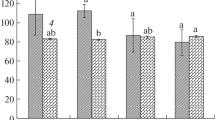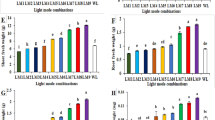Summary
Tomato seedlings were grown under seven kinds of fluorescent lamps, including two that are commercially available, and five experimental lamps. Detailed descriptions and spectral emission curves for these lamps are presented.
The 78/22 lamp, which emitted most of its energy above 500 mμ, more than ten percent above 700 mμ, and had a sharp peak output at 660 mμ, generally produced superior fresh and dry weight yields. This effect may be due primarily to the high peak of energy emitted at approximately 660 mμ, combined with a considerable emission in the far-red, which in turn may be related to the red ↔ far-red reversibility phenomeon.
The Com I lamp, which lacked the sharp peak output at 660 mμ and emitted more energy in the blue than the 78/22 lamp, was generally second only to the latter in promoting plant growth. A high moisture content was found in plants under this lamp in some experiments.
The IRIII lamp had the sharp peak output at 660 mμ but greater output in the blue than the 78/22 lamp. The 282 lamp output was similar to the 78/22 but lacked the high peak. Both of these lamps generally gave improved results over those produced by commercial Gro-Lux, Warm-white, and FLAT lamps. This was attributed to the greater percentage of red and far-red energy emission by the former two lamps. The yields with the FLAT lamp were consistently lowest of all. This has been attributed to the high percentage of emitted energy in the blue and green portions of the spectrum.
Both length of the test period (13 days versus 26 days) and light intensity (550 μw/cm2 versus 1100 μw/cm2) may be important factors in determining which composition of spectral energy emission produces the greatest yields. Under low intensity and short test period the Com I light produced highest fresh- and dry-weight yields, but under high intensity and longer growth period the 78/22 lamp gave greatest yields. This effect may be due to inhibition of leaf expansion by red light in the early stages of growth.
The experiments demonstrate that it is possible to develop a fluorescent lamp for plant growth that combines the desirable characteristics of both incandescent and fluorescent light. This work also shows that the tomato plant in the seedling stage grows best under an artificial light source with a high percentage of energy emission in the red, a considerable amount in the far-red, and a very small amount in the blue part of the spectrum.
Similar content being viewed by others
Literature
Committee on Plant Irradiation: Specification of radiant flux and radiant flux density in irradiation of plants with artificial light. J. Hort. Sci. 28, 177–184 (1953).
Downs, R. J., K. H. Norris, W. A. Bailey, and H. H. Klueter: Measurement of irradiance for plant growth and development. Proc. Amer. Soc. Hort. Sci. 85, 663–671 (1964).
Dunn, S.: These plants grow without sunlight. Trans. Amer. Soc. Agric. Engrs. 1, 76, 77, 80 (1958).
—, and F. W. Went: Influence of fluorescent light quality on growth and photosynthesis of tomato. Lloydia, 22, 302–324 (1959).
Gabrielsen, E. K.: Influence of light of different wave lengths on photosynthesis in foliage leaves. Physiol. Plantarum (Copenh.) 1, 113–123 (1948).
Helson, V. A.: Comparison of gro-lux and cool-white fluorescent lamps with and without incandescent as light sources used in plant growth rooms for growth and development of tomato plants. Canad. J. Plant Sci. 45, 461–466 (1965).
Hoover, W. H.: The dependence of carbon dioxide assimilation in a higher plant on wave length of radiation. Smithsonian Misc. Coll 95, No. 21 (1937).
Kwack, B. H., and S. Dunn: Effects of light quality on plant maturity. I. Duration of growth, nutrient supply, and photoperiod. Lloydia 24, 75–80 (1961).
Leiser, A. T., A. C. Leopold, and A. L. Shelley: Evaluation of light sources for plant growth. Plant Physiol. 35, 392–395 (1960).
Naylor, A. W., and G. Gerner: Fluorescent lamps as a source of light for growing plants. Bot. Gaz 101, 715–716 (1940).
Stevenson, E. L., and S. Dunn: Plant growth effects of light quality in sequences and in mixtures of light. Advanc. Front. Plant Sci. 10, 177–190 (1965).
Stoughton, R. H.: Light and plant growth. I, II. J. Roy. Hort. Sci. 80, 454–467 (1955a), 494–506 (1955b).
Vince, D., and R. H. Stoughton: Artificial light in plant experimental work. In: Control of the plant environment (J. P. Hudson, ed.), p. 72–83. London: Butterworths Sci. Publ. 1957.
Went, F. W.: The experimental control of plant growth. Waltham, Mass.: Chron. Bot. 1957.
Withrow, A. P., and R. B. Withrow: Plant growth with artificial sources of radiant energy. Plant Physiol. 22, 494–513 (1947).
Author information
Authors and Affiliations
Additional information
This research was submitted by the senior author in partial fulfillment of the requirements for the M. s. degree in Botany at the University of New Hampshire.
Published with the approval of the director of the New Hampshire Agricultural Experiment Station as Scientific Contribution No. 397. This study was part of the Northeast Regional Project, NE-35, Analysis of Northeastern Climatic Variables and Their Relationships to Plant Response.
Rights and permissions
About this article
Cite this article
Thomas, A.S., Dunn, S. Plant growth with new fluorescent lamps. Planta 72, 198–207 (1966). https://doi.org/10.1007/BF00387483
Received:
Issue Date:
DOI: https://doi.org/10.1007/BF00387483




